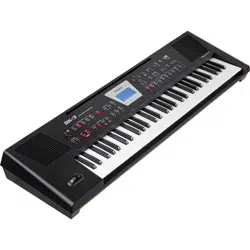Loading ...
Loading ...
Loading ...

‘Performance Edit’ parameters
49
• “Pianist2”: Same as “Pianist1” while the Hold pedal is not
pressed. If you press the Hold pedal, the BK-3 even recognizes
“chords” when you press only one note. If the hold pedal is still
pressed, chord recognition continues up to a maximum of 5
played keys.
• “Intelligent”: Select this option when you want the chord
recognition function to supply the missing notes of the chords
you play.
• “Easy”: This is another “intelligent” chord ngering system. It
works as follows:
Chord Type Action
Major chords
Press the key that corresponds to the chord’s
fundamental.
Minor chords
Fundamental + any black key to the left of the
fundamental.
Seventh chords
Fundamental + any white key to the left of the
fundamental.
Minor seventh
chords
Fundamental + any black key to the left + any white
key to the left.
Arranger Hold
This function sustains the notes you play in the chord recognition
area (“Zone”). Select “O” if you want the accompaniment to stop
as soon as the keys in that zone are released. This parameter is
switched “On” by default.
Parameter Setting
Arranger Hold O, On
Tempo
Each rhythm has a preset tempo that is recalled when a rhythm is
selected. This parameter allows you to specify if and when the BK-3
should ignore the preset tempo and go on using the tempo of the
previously selected rhythm.
Parameter Setting
Tempo Preset, Auto, Lock
Here is what these three options mean:
Setting
Selecting a new rhythm
Playback is stopped Playback is running
Preset The rhythm’s preset tempo is loaded.
Auto
The BK-3 loads the
preset tempo of the
new rhythm
The BK-3 doesn’t load the
preset tempo of the new
rhythm.
The new rhythm is played at
the current tempo.
Lock
The BK-3 doesn’t load
the preset tempo of
the new rhythm. It is
played at the current
tempo.
NOTE
The setting of this parameter is neither saved to the
Performance memories, nor to the Global area. See “Save Global”
(p. 53). The “Lock” setting can also be activated by pressing
and holding the [TAP TEMPO] button.
Fill In Half Bar
When this parameter is “On”, the length of the Fill-Ins, which are
played when the [AUTO FILL IN] button lights, is halved.
Parameter Setting
Fill In Half Bar O, On
Certain pop songs in 4/4 contain bars that only last two beats.
The usual place for such a bar is between the rst and the second
verse. Another favorite position for “halved” bars is at the end of a
chorus or the bridge. Your BK-3 allows you to faithfully reproduce
these “anomalies” using this function. This does not change rhythm
playback right away. Only when another VARIATION pattern starts
will the “Fillin Half Bar” function be activated and play half the
number of beats of the accompaniment pattern you selected.
Fill Ritardando
This function is suitable for ballads. It causes the next Fill-In to slow
down (“ritardando”). See “Tempo Change Fill Rit” below for how to
set how strongly the tempo should be decreased.
Parameter Setting
Fill Ritardando O, On
As the name implies, it is only available while the [AUTO FILL-IN]
button lights.
a. Set “Fill Ritardando” to “On”.
b. Press the [START/STOP] / [ */, ] button to start rhythm playback.
c. Press a VARIATION [1]~[4] button.
The BK-3 plays a Fill-In. The tempo slows down while the ll is being
played. At the end of the ll, the rhythm returns to the previously
set tempo (this is called “a tempo”).
d. Press and hold the [EXIT] button to return to the main
page.
TempoCh Acc/Rit, TempoCh CPT, TempoCh Fill Rit
The “TermpoCh Acc/Rit” parameter allows you to speed up or slow
down the rhythm tempo by the amount you set here. To use these
functions, you must assign them to an optional footswitch (p. 52).
There are three Ritardando functions: one for all rhythm patterns,
one for Ending patterns and one for ll-ins (see “Fill Ritardando”
above). They all use the “Tempo Change” settings on the following
page.
Parameter Setting
TempoCh Acc/Rit 5%~92%
TempoCh CPT 0~3825
TempoCh Fill Rit 5%~92%
“TempoCh Acc/Rit”: Allows you to set the degree (ratio) by which
the tempo changes when the “Acceler” or “Ritard” function is
triggered. Example: if the tempo is currently� = 100, the value “20%”
means that the tempo drops to q = 80 or rises to q = 120
“TempoCh CPT”: Use this parameter to specify how long a
ritardando/accelerando should take. In most cases, 480 CPT (i.e. one
measure) is probably the most musical choice.
Loading ...
Loading ...
Loading ...
